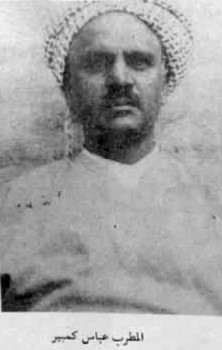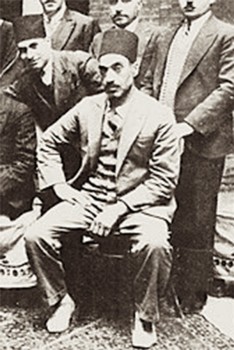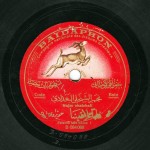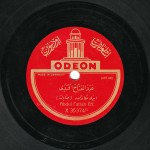The Arab Music Archiving and Research foundation (AMAR), in collaboration with the Sharjah Art Foundation (SAF), presents “Min al-Tārīkh”.
Dear listeners,
Welcome to a new episode of “Min al-Tārīkh”.
Today, we will be resuming our discussion about the disciples of al-ṭarīqa al-Zaydāniyya and about ‘Abbās Kambīr al-Shaykhalī.
The ṭāhir is from the scale of the maqām jahārkāh…
(♩)
This was an example of the maqām ṭāhir.
The principal bayyāt in Iraqi maqām is the same, as to the expression, as the khanabāt: it is between the nahāwand and the bayyāt.
But it sets on the qarār, not on the muṣannaf.
Excuse me?
It sets on the dūkāh, not on the nawa.
Indeed… It starts on the dūkāh…
(♩)
This was an example of the beginning of the maqām bayyāt that is beautiful of course and that features authentic old classical expressions that may not be enjoyed by today’s generation, because they are old condensed expressions.
In his book “A‘lām al-maqām al-‘irāqī wa-ruwwāduh”, researcher Kamal Latif Salim wrote: “Muṭrib ‘Abbās Kambīr al-Shaykhalī is a significant figure in the history of Iraqi maqām singing”. Adding that he was among the few reciters who had a melodious voice that was well appreciated by those who loved beautiful moving voices and well-structured performances. Consequently, muṭrib ‘Abbās Kambīr al-Shaykhalī occupies a major position among the maqām reciters who offered both a structured performance and a beautiful voice.” He also added that “muṭrib ‘Abbās Kambīr al- died in Baghdad in 1967. Furthermore, he stated that ‘Abbās Kambīr was an amateur singer of Iraqi maqām, and never became a professional Iraqi maqām singer, despite his mastery of this difficult singing type. Researcher Kamal Latif Salim also cited, in this same book, the words of Iraqi maqām expert ‘Izzat al-Maṣraf who stated that “muṭrib ‘Abbās Kambīr recorded in 1927 with the foreign record companies that came to Baghdad within their tour to record the heritage of peoples.
Towards the end of his life, ‘Abbās Kambīr was appointed as Iraqi maqām expert at the Iraqi Radio for a period of time.
He sang the following poem to the maqām ḥusaynī:
“Ayyi ‘udhrin li-man ra‘āka wa-lā mā”
And to the maqām nawa:
“Ramat al-fu’ād malīḥatun ‘adhrā’u bi-sihāmi laḥẓin mā la-hunna dawā’u”.
Let us talk now about Yūsuf Ḥuraysh, i.e. Yūsuf Ḥuraysh Bin Sāsūn Bin Shuwa‘ Bin ‘Ezrā Bin Ḥākhām Alī‘āzar Bin Sāliḥ, whose ancestors were Austrian Jews who settled long ago in Iraq in Baṣra in the far south of Iraq. Yūsuf Ḥuraysh was born in Baghdad in maḥallat –or ḥārat– “Qādī al-ḥājāt” in 1889 and died in occupied Palestine in 1961 after he had emigrated there in the 1950s. He learned Iraqi maqām under Aḥmad al-Zaydān and Rūbīn Bin Rajwān –an Iraqi Jew-, then sang at the Iraqi Radio for a long period of time. According to Ḥāj Hāshim al-Rajab, his Iraqi citizenship was taken away from him after he emigrated to occupied Palestine in 1951. He recorded a phrase of maqām-s, including the ḥijāz, i.e. the principal maqām ḥijāz dīwān. Note that, in Iraq, the maqām ḥijāz is called maqām ḥijāz dīwān. The reasons are:
The style –or the expressions– of the maqām ḥijāz dīwān in the maqām performance is influenced by the Turkish style. And, even though it is sung to the dūkāh scale-step, all its fundamental positions within the performance are set at the ḥusaynī (La). And since the ḥijāz is sung following the Turkish style in Iraq, most of its sections’ qafla-s are to the ḥusaynī even though it is a ḥijāz / dūkāh and this is called a dīwān according to the Tutkish, consequently, this ḥijāz singing style was named ḥijāz dīwān. I explained all this to justify the appellation ḥijāz dīwān given in Iraq to the ḥijāz.
Yūsuf Ḥuraysh recorded numerous maqām including the: ḥijāz dīwān, manṣūrī, nawa, khanabāt, sikāh, jūbūrī, ‘ajam, quryāt, ḥusaynī, ḥakīmī, and ḥadīdī. The maqām nawa that he recorded was considered as the most marvellous sample of this maqām. When Umm Kulthūm visited Baghdad in 1933, he sang for her during a private concert held in her honour by Yūsuf Za‘rūr al-Kabīr.
Yūsuf Ḥuraysh was among the great singers as well as those who were the most knowledgeable as to Iraqi maqām-s and their structure. Let me add that the maqām nawa was also used in the qaṣīda of Ibn Nabāta al-Maṣrī and is among the marvels of Arabic lyric poetry.
Muḥammad Bin Nabāta was a great poet in the 14th century.
Yes, Ibn Nabāta al-Maṣrī… Jamāl al-Dīn Ibn Nabāta.
He sang the verses except for the beginning that is as follows:
Awdat fi‘āluka yā isman bi-aḥshā’ī wā ḥayratī bayna af‘ālin wa-asmā’i
In kāna qalbuka ṣakhran min qasāwatihi Fa-inna qalb al-mu‘anna qalbu khansā’i
Wow!
He starts this beautiful qaṣīda from the following beautiful verse:
Yā’ ṣāḥibayya aqilla min malāmikumā wa-lā tazīdā bi-tikrāri al-hawā dā’ī
This beautiful qaṣīda was performed to the nawa…
(♩)
Shahāb al-A‘ẓamī sang the same qaṣīda… we may discuss this within our discussion on the disciples of the ṭarīqa Qundargiyya who included Shahāb al-A‘ẓamī who sang this qaṣīda to the maqām nawa:
Awdat fi‘āluka yā isman bi-aḥshā’ī wā ḥayratī bayna af‘ālin wa-asmā’i
In kāna qalbuka ṣakhran min qasāwatihi Fa-inna ṭarf al-mu‘anna ṭarfu khansā’i
Wayḥ al-mu‘anna al-ladhī aḍramta bāṭinahu Mādhā yukābidu min hawlin wa-ahwā’i
Yā’ ṣāḥibayya aqilla min malāmikumā wa-lā tazīdā bi-takrāri al-hawā dā’ī
Another artist, who was not treated fairly by historians –in fact many were not given their due, so I am attempting to shed a light on them because they did not get the attention, fame, or appreciation they deserve–, is muṭrib Yūsuf Karbalā’ī (1883 – 1961) born in Baghdad in maḥallat or ḥārat “al-Qaraghūl” according to the historians, who was nicknamed Karbalā’ī because he settled for a long time in Karbalā’ in the centre of Iraq. He performed religious rites, including the manqaba nabawiyya and dhikr and rubbed shoulders with Sheikhs as well as with the reciters of these religious rites. Moreover, he sang Iraqi maqām and heritage songs starting 1917, until he recorded a number of maqām-s and songs in 1924 with Polyphon and Odeon.
Yūsuf Karbalā’ī was the first to attempt fusion (talmī‘) between the qarīd and the bastah in a scanned and beautiful form whose maqām beats were different from those performed by his peers. I have a two hour’ tape recording of Ḥāj Yūsuf Karbalā’ī of a collection of copied discs. The scansion specific to his style is different from that of all the other performers. I described him as the pioneer of fusionb because of the way he scanned the words and the performance, such as in…
(♩)
And in…
(♩)
A very particular style indeed.
This is a famous song of his, where he tells the story of a man…
He was an entertaining performer.
Entertaining indeed. He was ironic yet realistic. The song, or disc, tells the story of a ninety year’s old man, with a white cottony beard, who already had two wives and wished to marry a third woman.
Ḥāj Yūsuf Karbalā’ī was born in a certain environment and decided to tell about the life he lived among his neighbours. These are the circumstances he always insisted on expressing throughout his artistic journey, and which he related sarcastically through an entertaining yet solid style, while abiding, as much as possible, by the rules pertaining to the performance of maqām as a heritage form.
Ḥāj Yūsuf Karbalā’ī produced a collection of recordings that is quite significant as compared to the production of his contemporaries. In fact, I can define him as a muṭrib maṭbū‘, i.e. a creative muṭrib whose style was different from that of his peers, as he relied on the traditional maqām form, but performed its shape and content in a personal style characterized by the expressions drawn from his environment and the entertaining artistic style that he adopted.
There is another famous song that he interpreted, I think, to the maqām ḥijāz… “Ḥabībī rāḥ”…
(♩)
I think that he composed the music of this famous song.
(♩)
Dear listeners, we have reached the end of today’s episode of “Min al-Tārīkh”.
We thank Mr. Husayn al-A‘zami as well as all those who participated in enriching the collection of AMAR with their recordings.
Today’s episode included recordings from the AMAR’s private collection added to those mentioned during our previous episode.
We will meet again in a new episode of “Min al-Tārīkh” to resume our discussion about the disciples of al-ṭarīqa al-Zaydāniyya.
“Min al-Tārīkh” is brought to you by Mustafa Said.
- 221 – Zakariyya Ahmed – 12 (1/9/2022)
- 220 – Zakariyya Ahmed – 11 (1/9/2022)
- 219 – Zakariyya Ahmed – 10 (11/25/2021)
- 218 – Zakariyya Ahmed – 9 (10/26/2021)
- 217 – Zakariyya Ahmed – 8 (9/24/2021)
- 216 – Zakariyya Ahmed – 7 (9/4/2021)
- 215 – Zakariyya Ahmed – 6 (8/28/2021)
- 214 – Zakariyya Ahmed – 5 (8/6/2021)
- 213 – Zakariyya Ahmed – 4 (6/26/2021)
- 212 – Zakariyya Ahmed – 3 (5/27/2021)
- 211 – Zakariyya Ahmed – 2 (5/1/2021)
- 210 – Zakariyya Ahmed – 1 (4/28/2021)
- 209 – W-al-Lāhi lā astaṭī‘u ṣaddak 2 (4/6/2017)
- 208 – W-al-Lāhi lā astaṭī‘u ṣaddak 1 (3/30/2017)
- 207 – Bashraf qarah baṭāq 7 (3/23/2017)




